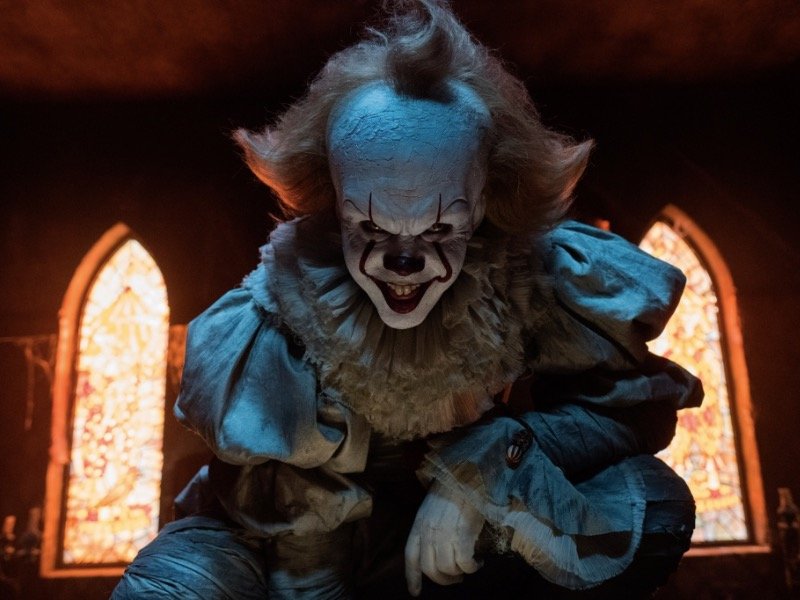It takes a lot of nerve to adapt "It" for the big screen.
Stephen King’s beloved and bountiful book spreads only over a thousand pages, with two interwoven stories told decades apart, seven kid leads, countless tricky tonal shifts and odd details, and one obviously unfilmable kid orgy – and that’s not even including this particular project’s decade of production work, a director dropout and the imposing shadow of an iconic villain performance. So credit where credit is due: Andy Muschietti’s "It" actually made it – and in one piece (well, actually, two pieces; the adult years will be its own sequel).
Unfortunately, save for coulrophobics and globophobes – respectively, those afraid of clowns and balloons; yes, the latter has its own word – the final product takes far less nerve to watch. As a potent horror movie, the most haunting part of the novel’s first big-screen foray (reminder: the Tim Curry classic was a TV miniseries) ends up being how simultaneously close and far "It" is to greatness.
While pop culture’s current favorite decade, the ’80s, takes the ’50s place, the outline of King’s story faithfully stays about the same: A gang of young outsiders take a break from fearing the kind of blindly murderous rage bullies they just don’t make in movies anymore to do battle with a new terror: a malevolent, otherworldly monster disguised as a clown, floating around the small town's sewers, picking off children to the adults’ collective apathy. The worst summer vacation ever ensues, along with the death of the real-world clown industry.
Or maybe not. For a movie that throws a ton of scares at the screen – very literally – "It" is startlingly lukewarm at startling the audience, to the point that some defenders argue it’s not actually to be judged as a horror movie but as a psychological thriller. But forget that; it’s definitely a horror flick – if anything, it trims the greater psychological nuance and subplots for the sake of pushing funhouse jolts – just one that’s not great at scaring.
Take its opening setpiece: little Georgie meeting Pennywise the Dancing Clown (Bill Skarsgard) in a rainy sewer grate. For the most part, it’s an eerie, uneasy scene … before all that is discarded to turn Pennywise into a loud, rubbery, computer-enhanced tooth monster, showing its hand right away and sending all that eerie mystery and intrigue down the drain, along with poor Georgie.
That’s unfortunately where "It" settles too often for its scares, Muschietti’s bag of tricks frequently limited to rubbing its crooked monsters’ faces into the camera – whether Pennywise, a leper or some other demon from Derry’s past. Or having Pennywise aggressively shimmy at the audience en route to then rubbing his face into the camera, with the standard-issue modern horror shrieking on the soundtrack. Save for a few clever twists – the scare involving a projector, for instance, which smartly shocks by playing with editing rhythm and size – the jumpy thrills get repetitive fast. Seen one bendy-faced monstrosity leer at the lens while the orchestra has a panic attack, seen them all.
The script’s pacing – from Chase Palmer, Gary Dauberman and Cary Fukunaga – doesn’t help, as it struggles to simplify the thematic and emotional depth of King’s book, especially when it comes to the silent menace of the town and, thanks to the time split, how the past still haunts the present. And how could it? The novel is a monster in its own right; even the four-hour miniseries couldn’t cram it all in. (Not to compare Muschietti’s capable if not hugely compelling approach to a movie that’ll never exist, but one wonders what original director Fukunaga could’ve done for that short-changed aspect considering how essential the murky fog of dread was for "True Detective" season one.)
Still, since that depth isn’t there, the first act feels clunkily paced and repetitive, with each kid getting a five-minute scene of being chased by the deformed ghoul of their displeasure before rewinding and playing the same verse with a new kid. By the time the Losers Club is entirely assembled, Muschietti finds more of a flow and story momentum – but, even then, the script struggles to find new scare tactics other than luring a kid alone in a room with a mixed-up Picasso face or clown running to smooch the camera with just enough unneeded CGI to serve as an unwanted accessory to the assault.
Maybe the shortcomings hurt more because "It" has the parts of an all-timer. Skarsgard is alarmingly good as Pennywise – painting with a different, unnervingly playful and alien shade of menace from Tim Curry’s famed performance. While his introduction ends on a disheartening note, everything before is great, a sweet and innocent precious kid talking to this grimly gleeful, peppily growling presence, eyes glowing in the darkness, drool dripping from his bent toothy grin and his guard dropping just enough to show it's all an impressive person suit. Forget the chomping: It’s the grimly gleeful performance, the details and the cruel manipulation that’s truly creepy and off – well, even more off than a clown casually hanging in a sewer.
While Pennywise jigs around in the spotlight, the real keys to a successful "It" (at least in this bifurcated version) are his young victims. Thankfully, Muschietti collected an impressively charming roster of young actors to bring the "Stand By Me"-esque coming-of-age tale to life, while also running for their own.
Between this and Netflix’s "Stranger Things," Finn Wolfhard has mastered the art of being menaced by monsters in small ’80s towns, adding comic relief to his resume as the squirrelishly charismatic and immature joker Richie. Meanwhile, Jaeden Lieberher ("Midnight Special") takes over the main role as Bill, the club’s quiet leader, sturdily serving as the devastating emotional crux of the story – coming to terms with his little brother’s gruesome disappearance, all while also impressively selling a stutter.
Newcomer Jack Dylan Grazer acquits himself with snap as Eddie, the group’s fast-talking hypochondriac, while Jeremy Ray Taylor sweetly warms as Ben, the big-hearted new kid in town. Chosen Jacobs and Wyatt Oleff round out the rest of the gang as Mike and Stanley, attempting to make an impact while unfortunately given the least of everyone to do (especially the former, who joins late and is all character bulletpoints and no room to breathe). The real standout from this boys club, however, is its lone girl: Sophia Lillis, playing the tortured young Beverly Marsh, having to grow up too soon deflecting small-town rumors, bullies and an abusive father.
On their own, they’re very good – especially Lillis, who plays Bev’s soft armor perfectly – but together, the movie becomes a delight as the Losers Club bounces off each other, crassly and callously razzing one another as only friends who actually care can. They’re enough to make the audience regret they won’t get another movie of their spirited chemistry, but at least together they make their chapter work, their fun and free heart making up for the lesser frights – and for the lesser themes. Derry’s haunted coldness gets a few token nods, but at least the kids help sell the end of the last summer vibe, of children facing dark adulthood with no one to shine a light but one another.
So the cast clicks, and when Muschietti pumps the breaks on the predictable, he can concoct some really effectively chilling moments. Ben flipping through a book, page by page honing in a dead boy’s photo, all while a librarian quietly hunches as a darkly smiling blur in the background, is far more spine-tingling than a headless boy and a clown playing Pac-Man with Ben through some library shelves. The same goes for Pennywise’s later interaction with a lone Losers Club member with a busted arm, which easily out-creeps the obvious clown jump factory from just minutes before.
Unfortunately, Muschietti is stuck in the final act of his 2013 debut "Mama" (aka the bad act), wildly punching at the audience’s fears, visual horrors and tones, not trusting that an unsettling nudge will do the trick. A clown using a young mindlessly grinning child as a puppet? Creepy – but what if the kid’s face also digitally rotted away!? Add CG motion blur and menace face to the monsters – nevermind that the design, the performance and veteran practical effects masters Alec Gillis and Tom Woodruff – an admittedly nice touch – are already working overtime to haunt (a better touch: using subtle effects to make Pennywise’s head and body movements seem stiffly disconnected). Muschietti’s mode is playing carnival music or fire sound effects when characters talk about a carnival or a fire, underlining and highlighting what’s already in bold.
He already had the nerve to get "It" to theaters; next time, he’ll hopefully find the nerve to calm down, trust his audience and float some new tricks by his new cast.
"It": **1/2 out of ****
As much as it is a gigantic cliché to say that one has always had a passion for film, Matt Mueller has always had a passion for film. Whether it was bringing in the latest movie reviews for his first grade show-and-tell or writing film reviews for the St. Norbert College Times as a high school student, Matt is way too obsessed with movies for his own good.
When he's not writing about the latest blockbuster or talking much too glowingly about "Piranha 3D," Matt can probably be found watching literally any sport (minus cricket) or working at - get this - a local movie theater. Or watching a movie. Yeah, he's probably watching a movie.







